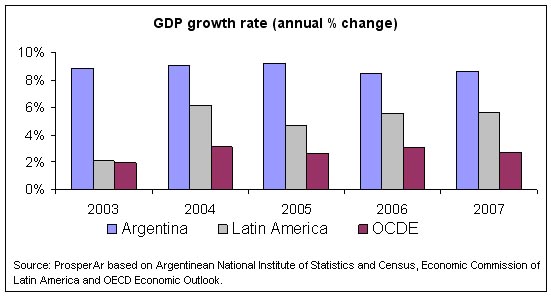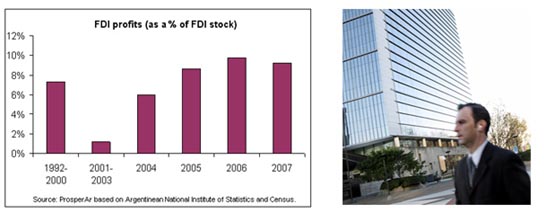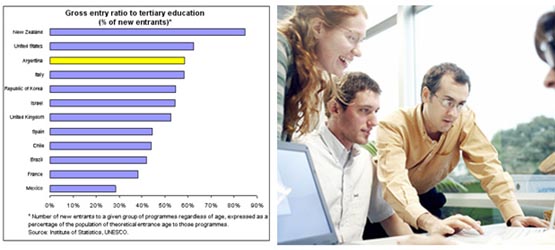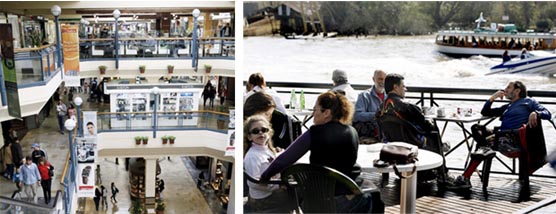Argentina Market
10 Reasons to Invest in Argentina
1. Sustained economic growth
Growth. Argentina is one of the fastest growing economies in the world. The compound annual growth rate for 2003-2007 was 8.8%, coming in just below China (10.7%) and India (8.9%), and well above all other Latin American economies. Projections for 2008 confirm this sustained growth trend. This strong economic performance led to a net job creation of 3.1 million positions since 2003. As a result, the unemployment rate is currently at the lowest point of the past fifteen years (7.5%).
Solid macro foundation. Investment—measured as a percent of GDP—reached 24.3% in 2007, the highest level of the last three decades, higher than Brazil, Chile and Mexico. Unlike previous growth cycles, Argentina shows a sound fiscal and current account surplus (3.2% and 2.8% of GDP, respectively). Furthermore, the Central Bank’s foreign exchange reserves remain at an unprecedented level (US$46.2 billion at the end of 2007). These performance figures are the basis of Argentina’s projected sustainable growth in the foreseeable future.
Exports. Exports doubled in the last five years, reaching US$65.8 billion in 2007 and a projected level of US$78.7 billion in 2008. Rising international prices, an expanding export capacity and a competitive real exchange rate were the key factors for such a performance. Not only traditional primary commodities are leading this growth, but also Argentine exports of manufactures (for example, automobiles, food and beverages, and design manufactures) and value added services (such as information technologies, professional consultancy, and tourism) are expanding at accelerated rates.
 |
2. Attractive business profitability
Business results. Argentina offers investors attractive profitability in a wide range of sectors. Earnings as a percent of Foreign Direct Investment (FDI) stock are currently at the highest level of the last 15 years and reached 9.3% in 2007. Earnings as a percent of revenues for the top 300 foreign companies operating in the country are also at elevated historical levels and averaged 12.6% in 2003-2005.
Legal framework. By law, FDI receives equal treatment than domestic investment. Free remittance of profits and capital abroad is allowed. There are no sectors restricted to transnational companies’ involvement. In addition, Argentina holds 19 bilateral treaties for the avoidance of double taxation and 55 bilateral investment treaties for the protection and promotion of investments.
 |
3. A globally and regionally integrated economy
Open economy. Trade, financial and investment flows link Argentina to the global and regional economy. Argentina is a founding member of the WTO and actively participates in the multilateral trading system. Argentina’s exports and imports of goods and services represent almost half of its GDP. The average import tariff for agricultural products is 9.9% and 10.5% for non-agricultural products. In addition, Argentina is a full member of Mercosur, a customs union which also includes Brazil, Paraguay and Uruguay (Venezuela is currently negotiating to become a full member of the trade bloc). The intra-Mercosur trade tariff is 0% and a Common External Tariff (CET) applies to trade with non-Mercosur countries. Mercosur is a common market open to the world. A Preferential Trade Agreement with India is in place, a free-trade agreement with Israel is awaiting Congress’ approval and diverse trade agreements are under negotiation with the Southern African Customs Union (SACU), countries of the Gulf Cooperation Council (GCC) and Morocco. A more comprehensive agreement with the European Union is under negotiation. Mercosur has also been an active participant in the negotiations of the Free Trade Area of the Americas (FTAA).
Mercosur. Mercosur offers investors in Argentina access to a large and attractive regional market as well as the market access benefits from trade negotiations with Latin America and third countries and regions. In Mercosur, Argentina has preferential access (0% tariff) to a regional market of 238 million inhabitants, with a combined GDP of US$1,607 billions (2007). Argentina’s outstanding economic performance has transformed the country into the main growth engine of Mercosur’s intra-regional trade, contributing 64% of the increase in intra-Mercosur imports in 1998-2007. As part of Mercosur, Argentina has signed Free Trade Agreements and/or Economic Complementation Agreements with Bolivia, Chile, Colombia, Ecuador, Peru and Venezuela (associate members of Mercosur).
Foreign direct investment. More than 1,000 overseas companies operate in the country, including half of Fortune 100 firms, and many have more than half a century of presence in the country. Transnational companies are involved in a wide range of activities in such diverse sectors as agro-industries, automotive industry, chemicals and petrochemicals, pharmaceuticals, information technologies, telecommunications, public utilities, finance and retail. Foreign firms represent 67% of the country’s 500 largest non-financial enterprises and account for more than 80% of their sales, three times the region’s average (ECLAC, 2007). FDI has exhibited a dynamic performance since 2004, and reached US$5.7 billion in 2007, a level 14% above 2006 inflows and also higher than last decade’s average annual flows net of privatizations (US$5.3 billion). Recent flows are the result of the increase in production capacity of transnational corporations with long-standing presence in the country and of new transnational firms entering the domestic market, resulting both in greenfield investments. Unlike previous phases, mergers and acquisitions represent currently a small part of total FDI (less than 5% in 2007) and reinvestment of earnings are at record-high historical levels (over 25%).
4. A diversified economy
Value added products. Argentina is a growing producer of technological and differentiated goods and services. In fact, it is the second largest producer of genetically modified crops, the world’s fourth largest producer and exporter of television content, and as any tourist will attest to: a world renowned producer of high-quality gourmet beef. The software and IT services industry has been growing at a compound rate of 20% per year since 2002; at the same time, its exports have been increasing at an annual rate of 24% for the same period. Automotive production and exports also expanded significantly, at a compound annual rate of 29% and 22%, respectively, over the last five years. Recent investments in agro-industry, biofuels, creative industries, professional services and tourism, among others, are also expanding the domestic production capacity for the local and global markets.
Commodity leader. Current and projected global consumption patterns and trends entirely match Argentina’s productive capacity. In a context of increasing global demand for food and natural products, Argentina is a key producer and exporter of commodities and raw materials: it is the world’s leading exporter of sunflower oil, soybean oil, pears and lemons, among a diversified basket of agricultural products. In fact, exports of primary products increased 90% over the period of 2003-2007 and exports of agricultural-based manufactured goods grew 92% in the same period, topping US$19 billion in 2007. The country shows a diversified export pattern, exhibiting an export concentration index that ranks Argentina right after Canada and the United Kingdom and over countries such as New Zealand, India, Mexico, South Africa and Australia, among others, according to the World Bank (World Trade Indicators, 2008).
5. Skilled and talented human resources
Human capital. Argentina is internationally acknowledged for its well trained and highly educated human resources. The country ranks first in the region in educational attainment and adult literacy and has educational levels similar to developed countries like Italy and Israel (UNESCO Global Education Database, 2007).
Brainpower. Argentina offers a pool of motivated and talented entrepreneurs. The country ranks 10th in the Global Entrepreneurship Monitor (2007) and counts with world-class business schools. More than 65,000 undergraduate and 4,600 postgraduate students from 103 universities across the country enter the labor market each year. English penetration is among the highest in the developing world, as shown by Cambridge University’s English Exams results that place Argentina above Brazil, Chile, France, Italy, Indonesia, Mexico and Spain (Cambridge ESOL, 2007).
Innovation driven. Argentina’s professionals also have outstanding capabilities for technological innovation. The number of scientists and engineers devoted to research and development activities per million inhabitants is higher than Brazil, Chile, Mexico and Uruguay (UNESCO, 2007). Notably, the number of patents per million inhabitants registered at the United States Patent and Trademark Office has been the highest in the region in the last 40 years (1963-2005).
 |
6. Abundant and diverse natural resources

Natural riches. Argentina is one of the world’s most geographically varied and resource rich territories. It is the second largest country in Latin America and the eighth in the world. Along its 2.8 million square kilometers Argentina is endowed with extraordinary fertile agriculture lands (mainly in the Pampa Húmeda), unexploited forest resources (mostly in the Northeast), exploitable mining deposits (along the 4,500 kilometers of the Andean Mountain Range) and rich fisheries (along the 4,700 kilometers of the Atlantic Coast).
Unique geography. Exuberant beauty and extraordinary flora and fauna spread along Argentina’s territory. Visitors are surprised by blue lakes, high peaks, large salt pans, paleontological sites, fertile valleys, snow-covered volcanoes, subtropical rain forests, white deserts, long rivers, great waters, boundless flat lands and vibrant cities. Argentina promotes sustainable development and natural resource protection. The country ranks 38th among 149 countries on the Environmental Performance Index (University of Yale, 2008).
7. Remarkable quality of life
Live Argentina. Argentina enjoys an outstanding quality of life; ranking 11th in the Quality of Life Index elaborated by the trade publication International Living (2008) and is the second top tourist destination in Latin America (World Tourist Organization, 2007). The high quality of life, rich cultural heritage and a people known for its hospitality and warmness make Argentina an exceptional place to live.
To your health. Argentina ranks first in Latin America in the United Nations Human Development Index (2007/2008) and in the UN Gender-related Development Index (2007/2008). In both the areas of health and education, there are prestigious local institutions whose services are comparable to their best international counterparts. Visitors will find a number of top bilingual schools specializing in the English, German, French and Italian languages, as well as complex care medical centers in every major city.
Tickets please. The vivacious life in Argentina’s main urban centers is world renowned, where dynamic and diverse cultural activities include 740 museums, 2,807 theatres and 498 cinemas. Argentina’s sporting events (the football classic—yes, soccer—Boca vs. River stands out), as well as the possibility to practice every imaginable sport, will impress any sports afficionado. Argentina was nominated the best golf destination in the region (International Golf Travel Market, 2007) for example.
Capital views. The capital city, Buenos Aires, is an attractive metropolis with first-rate hotels and restaurants, and an active nightlife. Calm residential neighborhoods in the suburbs to the busy streets lined with French style petits hôtels in Recoleta are but two of the diverse neighborhoods in the city. Buenos Aires is considered the second best city to visit in the world (Travel & Leisure, 2007) and ranks second in Latin America in the Worldwide Quality of Living Survey (Mercer Human Resource Consulting, 2007). Owing to its traditional design background and strong contemporary art scene, Buenos Aires was appointed first UNESCO City of Design in 2005.

8. A vibrant culture
Creative industries. Argentina is a country endowed with an enormously rich and varied culture. From music, dance and theatre to cinema, literature and plastic arts, the intense cultural life makes for a growing cultural and creative industry, which represents almost 3% of GDP (a level above the region’s average).
Tango. Tango music and dance are world renowned and today stand as the main “porteño” cultural icon, as shown by the growing sale of records, tickets for concerts, dance shows, dance classes, shoes, trinkets and specialized publications. Tango-themed tours are increasingly popular, as visitors cannot resist the music and dancing at Milongas, the tango events held at local dance halls.
Step by step. But not everything boils down to tango in Argentina. Folk dances are popular and a new generation of ballet dancers offers marvelous performances at the splendid Buenos Aires Opera House (Teatro Colón) and diverse open-air scenarios. Argentina is also known for its theater industry that can be compared to that of very few countries in the world; with over 200 plays shown regularly on Saturdays: 10 shows per hour. Indeed, the national film industry reached its height last decade with the arrival on the scene of young directors making up the “new Argentine cinema”. In 2007, Argentina experienced extraordinary growth in the movie industry, when 80 national films were released. The television content and advertising industries are also developing at high speeds and increasingly supplying regional and global markets.
Step by step. But not everything boils down to tango in Argentina. Folk dances are popular and a new generation of ballet dancers offers marvelous performances at the splendid Buenos Aires Opera House (Teatro Colón) and diverse open-air scenarios. Argentina is also known for its theater industry that can be compared to that of very few countries in the world; with over 200 plays shown regularly on Saturdays: 10 shows per hour. Indeed, the national film industry reached its height last decade with the arrival on the scene of young directors making up the “new Argentine cinema”. In 2007, Argentina experienced extraordinary growth in the movie industry, when 80 national films were released. The television content and advertising industries are also developing at high speeds and increasingly supplying regional and global markets.
Literature and works of art. Admiration for Argentine artists and authors goes well beyond the country’s national borders. The most famous of Argentine literature exponents is Jorge Luis Borges, but it also includes three other Miguel de Cervantes Prize winners (Ernesto Sábato, Adolfo Bioy Casares and Juan Gelman) and a new generation of gifted young writers. The Argentine people’s growing interest in reading can be measured by attendance records at the Buenos Aires International Book Fair, which was visited by 1.2 million people this year. Meanwhile, Argentine works of art are experiencing an unprecedented growth in sales with roughly 4,000 works sold in 2007 alone.

9. Quality connectivity and modern infraestructure
Wired. Argentina benefits from advanced and competitive telecommunications in a highly deregulated market. Large capital investments have resulted in digital networks with national and international connectivity. Fixed-line and mobile density in Argentina (105 subscribers per 100 inhabitants) is the highest in Latin America; while Internet penetration (21 users per 100 people) is increasing rapidly, ranking well above the region’s average (World Bank, 2008). Companies also value Argentina’s time zone (GMT-03:00), which allows them to efficiently serve both American and European markets.
High road. The country has a developed transport and infrastructure system: more than 38,700 kilometers of national roads; one of the longest rail road networks in the world (35,753 kilometers); 25 seaports and 38 river ports; and 58 airports (23 international). More than 25 airlines offer non-stop flights from Argentina to more than 40 destinations in five continents. In fact, Argentina ranks second in the Logistics Performance Index in the region and is the only Latin American country among the world’s top 50 countries in terms of ease and affordability of arranging international shipments (World Bank, 2007).

10. Public sector supportive of investment
ProsperAr. The recent creation of Argentina’s National Investment Development Agency, ProsperAr, is a clear sign of the government’s commitment to support the expansion of investment and the attraction of FDI for competitiveness and sustainable development.
Investment incentives. Argentina’s strategy to attract investment also includes a series of fiscal, export-related, training, innovation and industry-related incentives. A number of incentives designed to promote investment and improve profitability are in place at the national, regional and municipal level. Specifically, Argentina offers investors: fiscal and tax benefits to reduce the fiscal burden of the investment phase (0% tariff on imports of capital goods, accelerated depreciation for machinery and equipment, early recovery of Value Added Tax); incentives for export promotion (reimbursement of VAT, drawback mechanisms, temporary admission regime); fiscal credit for specific training programs; and funds for scientific and technological research and innovation. Furthermore, some investment schemes are in place in sectors such as software, biotechnology, biofuels, autoparts, mining and forestry.
